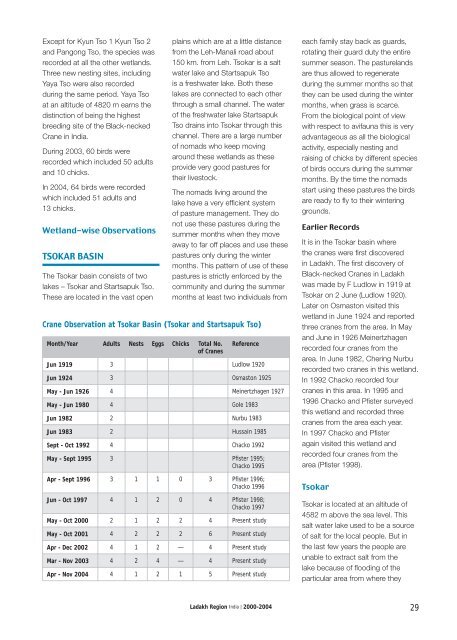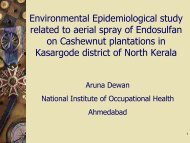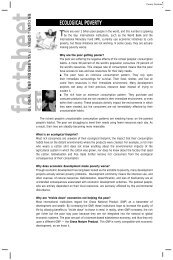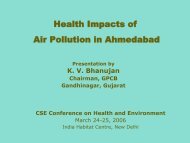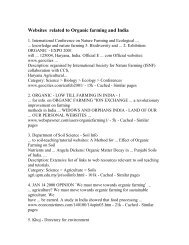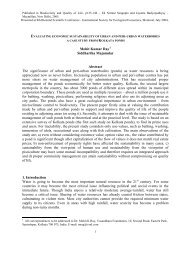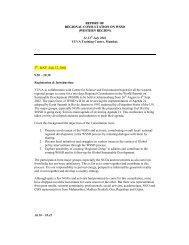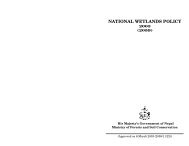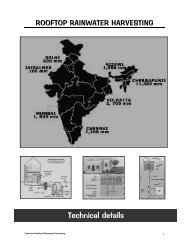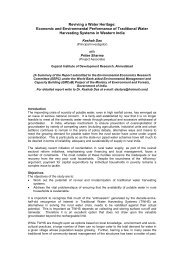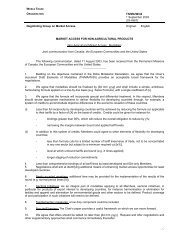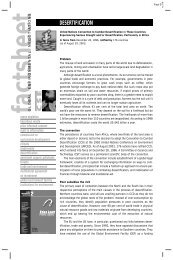Black-necked Crane - WWF-India
Black-necked Crane - WWF-India
Black-necked Crane - WWF-India
Create successful ePaper yourself
Turn your PDF publications into a flip-book with our unique Google optimized e-Paper software.
Except for Kyun Tso 1 Kyun Tso 2<br />
and Pangong Tso, the species was<br />
recorded at all the other wetlands.<br />
Three new nesting sites, including<br />
Yaya Tso were also recorded<br />
during the same period. Yaya Tso<br />
at an altitude of 4820 m earns the<br />
distinction of being the highest<br />
breeding site of the <strong>Black</strong>-<strong>necked</strong><br />
<strong>Crane</strong> in <strong>India</strong>.<br />
During 2003, 60 birds were<br />
recorded which included 50 adults<br />
and 10 chicks.<br />
In 2004, 64 birds were recorded<br />
which included 51 adults and<br />
13 chicks.<br />
Wetland-wise Observations<br />
TSOKAR BASIN<br />
The Tsokar basin consists of two<br />
lakes – Tsokar and Startsapuk Tso.<br />
These are located in the vast open<br />
plains which are at a little distance<br />
from the Leh-Manali road about<br />
150 km. from Leh. Tsokar is a salt<br />
water lake and Startsapuk Tso<br />
is a freshwater lake. Both these<br />
lakes are connected to each other<br />
through a small channel. The water<br />
of the freshwater lake Startsapuk<br />
Tso drains into Tsokar through this<br />
channel. There are a large number<br />
of nomads who keep moving<br />
around these wetlands as these<br />
provide very good pastures for<br />
their livestock.<br />
The nomads living around the<br />
lake have a very effi cient system<br />
of pasture management. They do<br />
not use these pastures during the<br />
summer months when they move<br />
away to far off places and use these<br />
pastures only during the winter<br />
months. This pattern of use of these<br />
pastures is strictly enforced by the<br />
community and during the summer<br />
months at least two individuals from<br />
<strong>Crane</strong> Observation at Tsokar Basin (Tsokar and Startsapuk Tso)<br />
Month/Year Adults Nests Eggs Chicks Total No.<br />
of <strong>Crane</strong>s<br />
Reference<br />
Jun 1919 3 Ludlow 1920<br />
Jun 1924 3 Osmaston 1925<br />
May - Jun 1926 4 Meinertzhagen 1927<br />
May - Jun 1980 4 Gole 1983<br />
Jun 1982 2 Nurbu 1983<br />
Jun 1983 2 Hussain 1985<br />
Sept - Oct 1992 4 Chacko 1992<br />
May - Sept 1995 3 Pfister 1995;<br />
Chacko 1995<br />
Apr - Sept 1996 3 1 1 0 3 Pfister 1996;<br />
Chacko 1996<br />
Jun - Oct 1997 4 1 2 0 4 Pfister 1998;<br />
Chacko 1997<br />
May - Oct 2000 2 1 2 2 4 Present study<br />
May - Oct 2001 4 2 2 2 6 Present study<br />
Apr - Dec 2002 4 1 2 — 4 Present study<br />
Mar - Nov 2003 4 2 4 — 4 Present study<br />
Apr - Nov 2004 4 1 2 1 5 Present study<br />
each family stay back as guards,<br />
rotating their guard duty the entire<br />
summer season. The pasturelands<br />
are thus allowed to regenerate<br />
during the summer months so that<br />
they can be used during the winter<br />
months, when grass is scarce.<br />
From the biological point of view<br />
with respect to avifauna this is very<br />
advantageous as all the biological<br />
activity, especially nesting and<br />
raising of chicks by different species<br />
of birds occurs during the summer<br />
months. By the time the nomads<br />
start using these pastures the birds<br />
are ready to fl y to their wintering<br />
grounds.<br />
Earlier Records<br />
It is in the Tsokar basin where<br />
the cranes were fi rst discovered<br />
in Ladakh. The fi rst discovery of<br />
<strong>Black</strong>-<strong>necked</strong> <strong>Crane</strong>s in Ladakh<br />
was made by F Ludlow in 1919 at<br />
Tsokar on 2 June (Ludlow 1920).<br />
Later on Osmaston visited this<br />
wetland in June 1924 and reported<br />
three cranes from the area. In May<br />
and June in 1926 Meinertzhagen<br />
recorded four cranes from the<br />
area. In June 1982, Chering Nurbu<br />
recorded two cranes in this wetland.<br />
In 1992 Chacko recorded four<br />
cranes in this area. In 1995 and<br />
1996 Chacko and Pfi ster surveyed<br />
this wetland and recorded three<br />
cranes from the area each year.<br />
In 1997 Chacko and Pfi ster<br />
again visited this wetland and<br />
recorded four cranes from the<br />
area (Pfi ster 1998).<br />
Tsokar<br />
Tsokar is located at an altitude of<br />
4582 m above the sea level. This<br />
salt water lake used to be a source<br />
of salt for the local people. But in<br />
the last few years the people are<br />
unable to extract salt from the<br />
lake because of fl ooding of the<br />
particular area from where they<br />
Ladakh Region <strong>India</strong> | 2000-2004 29


